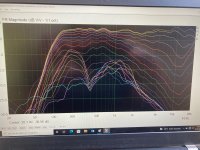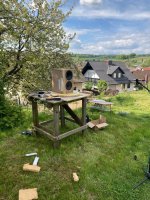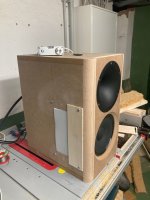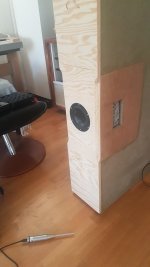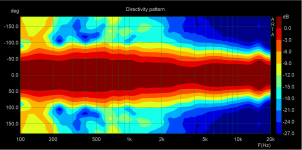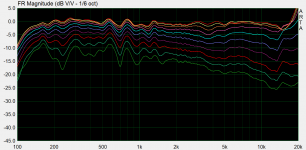Yeah ground plane measurements seem reasonable way to do it as long as the "floor" is reflective at the low frequencies. If both transducer and the mic was about 15cm / 6" from the ground and mic was 3m / 10' away then the path length difference through the ground is only about an inch (~2cm) which is 1/2wl above 8kHz which means the interference starts to affect the result above ~4kHz, in ideal case 🙂 In reality there would probably be some refraction and what not. Possibly not much of an issue inspecting the relatively low frequencies through.
ps. Exploiting simple specular reflection calculator for this, ignore the ceiling stuff for this 😀
ps. Exploiting simple specular reflection calculator for this, ignore the ceiling stuff for this 😀
Attachments
Last edited:
There are limitations on the ground-plane method.Yes. I am able to get resolution down to 20 Hz, as long as the ambient noise floor is good... i.e. waiting for no vehicles or other noise sources.
In theory, a ground plane measurement is equivalent to anechoic. In practice, we are limited by environmental considerations. But the rotation of the device under test is no obstacle at all.
Excellent thread on ground plane testing by Erin:
https://www.diyaudio.com/community/...how-close-is-close-enough-to-anechoic.353347/
Especially with higher frequencies.
But since we can stitch them with gated measurements, we can still get all the information we need.
It’s not about a 3D plot of data, but the ability to determine the near-field and far-field radiation point, and the derivation of the complex radiation pattern.How is that a necessity for making a great speaker design?
But besides that, 3D graphs can be done on multiple ways, it just takes an awful lot of time and most people don't even bother looking at it anyway (that's probably a reason that Erin doesn't show them as well).
2D contour plots (normalized) plus off-axis freq resp will give you most of the information you need.
Depending on application, the ability to determine the radiated sound profile at any distance and angle, perhaps for each individual driver, could be very useful. Of course, acoustic problems need a redo on waveguide or cabinet geometry so its clear why simulations tend to be the focus at that stage.
I’m still curious about speaker balloons generated from Klippel NFS. It strikes me as odd that they’re not more commonplace - or perhaps they are, and we simply aren’t told about them.
It would be nice to have the measured NFS data balloon from Erin or Amir available as a SOFA or OpenDAFF (both open source with no license needed for viewer software).
Interesting, can you elaborate on eBay you mean with near- and far- field radiation point?It’s not about a 3D plot of data, but the ability to determine the near-field and far-field radiation point, and the derivation of the complex radiation pattern.
Hi Keyser,It's been a while since I last logged onto my favorite forum. Today I came across this topic. I feel honored that people from this community where I've learned so much are now inspired by the 8c!
Some interesting subjects have been discussed here. However, it seems the same scientific facts and papers that are being discussed that were discussed years ago. There doesn't seem to be a lot of new factual information on cardioids. Unfortunately, in that sense, I don't have a lot to contribute either, just my own biased subjective experiences over the years.
With its waveguide and cardioid midrange, the 8c has constant directivity down to 100 Hz. If the 8c is placed relatively close to the front-wall (60 cm or less between the back of the cabinet and the boundary), below 100 Hz you'll get a hemispherical radiation pattern. That actually has a pretty good directivity match with the cardioid midrange. The benefit of this is that the 8c has more or less constant directivity even in rooms with a very low Schroeder frequency. This results in easy room integration in rooms of various sizes.
Much has been said about the 8c's rising distortion in the low mids and bass. In theory, it doesn't look very nice. In practice though, the 8c's sound clean and uncompressed, even at relatively high levels. It has a very effortless, relaxed quality to it. How is this possible?! It's a well-known fact that low-order harmonic distortion does not strongly correlate with sound quality. To a large extent, it's masked by other tones present in the music, and by the ear's own inherent distortion. Sure, whenever I see people online sharing distortion measurements of the 8c and commenting on them negatively, I kind of wish the numbers were better. But then I remind myself that it's the result of listening tests and a conscious engineering decision: Dutch & Dutch has a strong focus on science and objective data, but ultimately objective data are a means to a subjective end. Before there were any measurements to be found online, nobody ever complained about the 8c's not playing loud enough. Rather the contrary! Food for thought.
Before the 8c, we made a full-range cardioid sound reinforcement system, which consisted of a 2-way monitor consisting of a 15" passive cardioid midrange and 1" exit compression driver on a waveguide, combined with an active cardioid subwoofer with an 18" driver in the front and a 15" driver in the back. Based on non-controlled listening tests, I'd say the free-field (outside, no reflections) sound quality of a good cardioid subwoofer is more or less the same as a bass-reflex monopole - I don't recognize the sound quality issues described in this thread. I also never heard any of the softness that I've come to recognize (and sort of appreciate) from dipoles.
Around that same time, we also made a full-range cardioid hifi-speaker prototype. The bass section consisted of six 9" Scan-Speak 23W woofers per side. Just like other full-range cardioids I've heard through the years, this speaker sounded really good! However, we didn't do any controlled listening tests. I really wish we had properly compared them to a monopole and multi-sub system, but objective listening tests are just so much work to do well. Therefore, my subjective impressions are as biased as anybody else's.
The benefits of cardioid down to the modal range are too great to ignore. I've done many one-on-one comparisons and a cardioid simply sounds less colored, more open. It's easy to explain based on theory (neutral reflections plus less boundary interference). But when it comes to the bass, there are so many factors besides directivity that affect the sound. Speaker location plays an important role with respect to which modes are excited; distortions; what about room EQ? Are we listening at only one location, or does spatial variance play a role as well? And obviously, how well do results in one room translate to another? I'd love to be involved with proper scientific research on this topic, I feel it's long overdue. Who knows someday somebody will approach us to do a master's thesis on this subject with us.
Over the years my impression has remained that in the modal range the sound quality is remarkably well explained by steady-state frequency response alone. I'm a big proponent of using EQ to fix issues in the bass. Particularly if there's only one main listening position, simple room EQ leads to incredible improvements in most rooms. I also have a lot of experience with multi-sub + EQ, as per Todd Welti of Harman. It really works as advertised. The biggest advantage over just EQ is the reduced spatial variance. A cardioid has the interesting property that it couples to both the pressure and velocity parts of the mode. This probably is of benefit in most situations. Based on the theory I'd say a multi-sub system has less spatial variance than a full-range cardioid up to the second-order mode in any room dimension, but above that, I'd put my money on the cardioid.
Let's move on to the 8c's bass: it sounds really good. It actually surprised me how good it sounded, the first time I heard it. The boundary-coupling subjectively results in a very punchy, and fast bass. My theory is that it is because boundary coupling results in a phase-coherent first wave-front. However, I have no reason to assume you won't get similarly good results with a cardioid satellite speaker and separate subwoofers placed in different room locations, the corners perhaps. This is a relatively easy thing to compare, I'll probably do a proper blind comparison one of these days.
To Dave123: It's not easy to get the cardioid to work really well. There are a few DIY people and companies who have tried, but nobody seems to get results better than a wide-band rejection of approximately 10 dB relative to the front. That's what I got as well in my first few designs. I've since figured out a repeatable method to achieve between 15 and 20 dB. Inside I still feel like the DIY nerd I was ten years ago, and therefore I feel this urge to share all my 'secrets'. But my partners would be very angry with me if I did.
Some general pointers (some of which have been raised by others as well): the depth of the enclosure matters a lot; the kind of material has an influence (rockwool, fiberglass, polyester wool all work well); it generally helps to have the slots relatively close to the front baffle.
Here you'll find a photo of the inside of the 8c's cabinet: 6moons: audioreviews Dutch & Dutch 8c
The Olympus' cardioid works better than most I've seen, but only after I replaced the perforated back-panel with a solid panel: 2-way: Waveguide + Cardioid-like
If you feel the 8c doesn't play loud enough, I can highly recommend the 12" mid format with multi-sub!
8C's cardioid performance is truly exceptional especially at ~90 degrees.
As I understand, 8C is basically cardioid mid/high + integrated subwoofer. Did you ever consider a 2.1 high-end system format with a "slim" mid-high cardioid section and separated subwoofers?
Will it achieve similar cardioid performance for such hypothetical "8c 2.1" slim concept?
Best regards!
Last edited:
I am also in the process of building a Dutch Dutch 8c clone. So far I've had very good results with 1cm Basotect in the side openings and some wood shavings inside. But I'm not super happy yet. I would like to get the widening between 400-700Hz under control. The waveguide will also be revised again.


That is quite good already, what the back side looks like past 90 degrees off-axis?
Regarding the slight widening it almost looks there is narrowing at 200Hz instead 🙂 Have you copied the dimensions exactly? I suspect the pattern depends on the outside dimensions and the fact that the ports need to be at the baffle edge, use low diffraction edge as they have.
Regarding the slight widening it almost looks there is narrowing at 200Hz instead 🙂 Have you copied the dimensions exactly? I suspect the pattern depends on the outside dimensions and the fact that the ports need to be at the baffle edge, use low diffraction edge as they have.
Hi, yes I copied the 8c exactly but today I noticed the openings are 3cm too far back. I will change that. You can see measurements from 0 to 180 degrees in the appendix.
Attachments
We lately did some idea thefts / espionage and experiments on cardoide. We made a mock up cabinet for measuring on different openings, degrees of stuffing and uniform damping materials. At the first attempts, the closed cabinet sounded far better as the cardiode sounded rather wooly. Current adjusting are slots close to rear inner wall, area approx 40% of Sd and a felt density near 40 kg/m3. Just now we do compare different felt thicknesses between 25 and 50 mm. ( Dacron based pro- mat for HVAC sound attenuators). Cabinet inner depth is about 1.5x driver dia. Now the music and details really opened up and beats the closed box. Not that closed box 0,7 qtc bottom, but more defined. That might fit fine in our next line array with subwoofer drivers in closed cabinets at rear baffle. Drivers considered are Satori 1" BE with wave guide for tweeter, Satori 5" TX from about 100 hz and Wavecor 8" subs in closed cabinet at the rear. A Hypex 503. with dsp near the base plate at rear allows for different " nightmares" for extensive trials, measurements and fails, hi-fi police's head-shakes, good friends support, minor WAF input and hopefully at last - success.
Early mockup:
Early mockup:
Attachments
Last edited:
So it goes on.
New midrange driver /Visaton Al200)
New waveguide
Better enclousure
New damping
Better measuring vicinity
Much better success
New midrange driver /Visaton Al200)
New waveguide
Better enclousure
New damping
Better measuring vicinity
Much better success
Attachments
Hi Markback,
my old prototype enclosure was still too leaky at too many steles. The new one is now tight except for the outlets. The dimensions are exactly the same as the original. I think the highlight of the damping is that there has to be a bit of pressure despite the open housing. So it must not be as open as a dipole. There is 1cm thick Basotect in front of the slits. It is much harder for the air to get through there than through rock wool, Sonofil etc. At the moment there is only Sonofil in the housing. But I want to play with it a bit to eliminate some resonances.
my old prototype enclosure was still too leaky at too many steles. The new one is now tight except for the outlets. The dimensions are exactly the same as the original. I think the highlight of the damping is that there has to be a bit of pressure despite the open housing. So it must not be as open as a dipole. There is 1cm thick Basotect in front of the slits. It is much harder for the air to get through there than through rock wool, Sonofil etc. At the moment there is only Sonofil in the housing. But I want to play with it a bit to eliminate some resonances.
It's seem you're on a downwards slope there?So it goes on.
New midrange driver /Visaton Al200)
New waveguide
Better enclousure
New damping
Better measuring vicinity
Much better success
I would flip the mic and speaker around, facing the speaker toward the trees.
That way you will probably be able to even get a slight longer time window.
What window type are you using?
The shown measurement is actually ungated. I could not see a real reflection in the impulse response...so i didnt use a window.
That is really good results squeeze86 
Seem you have nailed the outlet material ..... where do you purchase the 1 cm Basotect and is it "real" Basotect or a variant of open cell melamine?
..... where do you purchase the 1 cm Basotect and is it "real" Basotect or a variant of open cell melamine?
You say you use a new waveguide ... which one?
Have you had any chance to listen to the difference in a room with the outlet/slots closed vs open?
I'm working a on a smaller PC speaker with 5" woofer and 1" dome with waveguide, and the intention was to try out either slots or going full in with side firing drivers to achieve CD down to say 200 Hz. I think just going waveguided for nearfield listening has been a learning. The sound is for sure different and more precise, but I think I'm giving up some of the airiness and room .... but having changed tweeter along the way makes this statement more uncertain, as I have observed a lot of difference in this change! All controlled with DSP and therefore same overall freq response.

Seem you have nailed the outlet material
 ..... where do you purchase the 1 cm Basotect and is it "real" Basotect or a variant of open cell melamine?
..... where do you purchase the 1 cm Basotect and is it "real" Basotect or a variant of open cell melamine?You say you use a new waveguide ... which one?
Have you had any chance to listen to the difference in a room with the outlet/slots closed vs open?
I'm working a on a smaller PC speaker with 5" woofer and 1" dome with waveguide, and the intention was to try out either slots or going full in with side firing drivers to achieve CD down to say 200 Hz. I think just going waveguided for nearfield listening has been a learning. The sound is for sure different and more precise, but I think I'm giving up some of the airiness and room .... but having changed tweeter along the way makes this statement more uncertain, as I have observed a lot of difference in this change! All controlled with DSP and therefore same overall freq response.
Great results! Pls tell us more about the tweeter and WG. Is it possible to print the WG?So it goes on.
New midrange driver /Visaton Al200)
New waveguide
Better enclousure
New damping
Better measuring vicinity
Much better success
Its the real Basotect, I only cut it into stripes.That is really good results squeeze86
Seem you have nailed the outlet material..... where do you purchase the 1 cm Basotect and is it "real" Basotect or a variant of open cell melamine?
You say you use a new waveguide ... which one?
Its my own design, i designed it with ath and Abec.
No. That won't work either, because the midrange cabinet is way too small to use it as a good closed box.Have you had any chance to listen to the difference in a room with the outlet/slots closed vs open?
I use the Visaton KE 25 SC without the grid and without the diffusor in the grid. Yes of course its possible i have also a printed WG for prototypes. I can give you the .stl or the whole ath cfg data if you want. Later the whole Front Baffle will be cut with a CNC.Great results! Pls tell us more about the tweeter and WG. Is it possible to print the WG?
May I ask where you're from? That style of housing and the landscape looks like it could be a few villages over where I grew up.So it goes on.
New midrange driver /Visaton Al200)
New waveguide
Better enclousure
New damping
Better measuring vicinity
Much better success
I'm also planning to build cardioid speakers, however I'm 'inspired' by active cardioids, because with them you only have to actually build the enclosure once and the rest is DSP fiddling.
Have you found a solution for adding LF drivers to the same enclosure as the MF driver, apart from sealing them off from each other?
- Home
- Loudspeakers
- Multi-Way
- Resistive port cardioid active speaker insipired by D&D 8C

